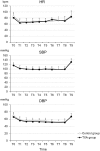Administration of tranexamic acid to patients undergoing surgery for adolescent idiopathic scoliosis evokes pain and increases the infusion rate of remifentanil during the surgery
- PMID: 28282425
- PMCID: PMC5345863
- DOI: 10.1371/journal.pone.0173622
Administration of tranexamic acid to patients undergoing surgery for adolescent idiopathic scoliosis evokes pain and increases the infusion rate of remifentanil during the surgery
Abstract
Background: We recently reported that tranexamic acid (TXA) evokes pain in rats by inhibiting γ-aminobutyric acid and glycine receptors on neurons in the spinal dorsal horn. Although TXA is commonly used to reduce perioperative blood loss during various surgeries, its potential to induce intraoperative nociception, thereby increasing the need for more analgesics during surgery, has not been investigated. Therefore, this study aimed to investigate whether TXA evokes pain and increases the need for a higher infusion rate of remifentanil in patients undergoing surgery for adolescent idiopathic scoliosis (AIS).
Methods: Data were collected from patients with AIS who underwent posterior spinal fusion surgery from January 2008 to December 2015. All surgical procedures were performed under total intravenous anesthesia with propofol and remifentanil, by the same team of orthopedic surgeons and anesthesiologists at a single institution. Patients in the TXA group were administered TXA (loading and maintenance doses, 1000 mg and 100 mg/h) whereas those in the control group were not. Our primary outcome was the infusion rate of the intraoperative opioid analgesic remifentanil.
Results: The final analysis was based on data collected from 33 and 30 patients in the control and TXA groups, respectively. No differences were observed in the demographic data or the hemodynamic parameters between the two groups of patients. In the TXA group, the durations of surgery and anesthesia were shorter, intravascular fluid volume and total blood loss were lower, and the doses of fentanyl and ketamine administered were higher than they were in the control group (P < 0.05 for all). The mean infusion rate of intraoperative remifentanil was significantly higher in the TXA group than in the control group (control group: 0.23 ± 0.04 μg/kg/min; TXA group: 0.28 ± 0.12 μg/kg/min; P = 0.014).
Conclusions: Patients who received TXA during the AIS surgery required a higher infusion rate of remifentanil, indicating that TXA evoked pain during the surgery.
Conflict of interest statement
Figures


References
-
- Andersson L, Nilsoon IM, Colleen S, Granstrand B, Melander B. Role of urokinase and tissue activator in sustaining bleeding and the management thereof with EACA and AMCA. Ann N Y Acad Sci. 1968;146:642–58. - PubMed
-
- Dunn CJ, Goa KL. Tranexamic acid: a review of its use in surgery and other indications. Drugs. 1999;57:1005–32. - PubMed
-
- Hoylaerts M, Lijnen HR, Collen D. Studies on the mechanism of the antifibrinolytic action of tranexamic acid. Biochim Biophys Acta. 1981;673:75–85. - PubMed
-
- Iwamoto M. Plasminogen-plasmin system IX. Specific binding of tranexamic acid to plasmin. Thromb Diath Haemorrh. 1975;33:573–85. - PubMed
-
- Thorsen S. Differences in the binding to fibrin of native plasminogen and plasminogen modified by proteolytic degradation. Influence of omega-aminocarboxylic acids. Biochim Biophys Acta. 1975;393:55–65. - PubMed
Publication types
MeSH terms
Substances
LinkOut - more resources
Full Text Sources
Other Literature Sources
Medical

